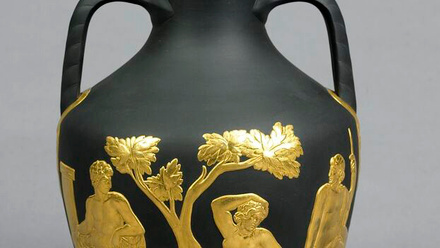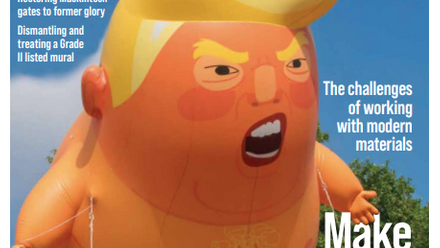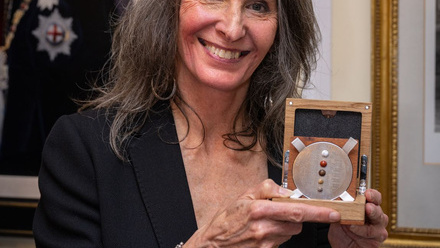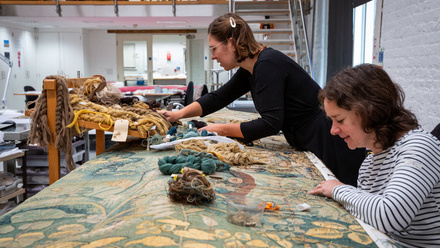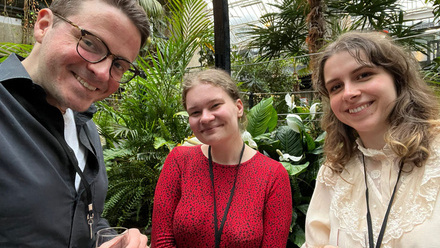The biennial award is the result of the collaboration between Nigel Williams’ family and the Icon Ceramics & Glass Group. It was created to serve both as a memorial to Nigel’s work and to encourage continuing high standards at all levels within the profession.
The Nigel Williams Prize seeks to recognise an outstanding professional or academic project focusing on the interventive conservation of ceramic or a directly related material. Submissions are welcome from individuals or teams from the private, the public or the educational sector.
We welcome applications from both residents of the UK and the rest of the World. To qualify for the prize, applicants should hold a professional membership. To be eligible, the project must have been completed within the three years prior to the submission deadline.
Judges
Each submission is assessed by a panel of three judges. The panel for the 2023 edition is composed of Loretta Hogan (Senior Ceramics and Glass Conservator, British Museum), Chair of the panel, Beky Davies (ACR, Ceramics Conservation & Restoration) and Peter David (ACR, PJD Ceramics).
Awards
- The Main Prize: The winning project receives £2,000.
- Runner-up Prize: The prize of £900 may be awarded to a close runner-up.
- The Student Prize: The winning project receives £600. Applications must have been completed while the applicant was still in education.
Who was Nigel Williams
Nigel Williams was the British Museum’s foremost expert on the conservation of ceramic and glass objects. His premature death from a heart attack in 1992, while working on a British Museum excavation in Jordan, left the conservation profession with a huge gap.
In 1961, in the days before conservation was a profession, the 16-year-old Nigel was recruited by the British Museum as a museum assistant in the Department of British and Medieval antiquities. He worked on all types of antiquities – metals, glass, stone, ivory and wood – but ceramics became his abiding passion.
His first success was the Sutton Hoo ship excavation. Originally discovered in 1939, this site was backfilled because of the war and only re-excavated in the late 1960s. Nigel was chosen to head the small team charged with conservation – or, in some cases, re-conservation – of the finds. They worked both on site (the mammoth task of making an entire fiber-glass and resin cast of the excavated ship in situ was exactly the sort of challenge that delighted the resourceful Nigel) and in the museum, on the magnificent burial goods found with it. Nigel’s enthusiasm and attention to detail set an example to those now entering the museum world as conservators. The highlight of this stage of his career was the dismantling of the 1940s restoration of the Sutton Hoo helmet, and its re-restoration to a new and altogether more credible shape based on the painstaking study of the profile, colour and morphology of more than 500 fragments.
In the late 1970s, the excavation of the wreck of the Colossus, which had gone down in 1798 off Scilly Isles, produced fragments of Greek vases from the collections of Sir William Hamilton. As many of these vases were known from contemporary illustrations, restoration was possible with relatively new fragments. This made good TV and the BBC’s Chronicle program showed Nigel Williams to be a ‘natural’ in front of the camera. Many people still remember the magic moment when he uttered a four-letter word when a partially completed restoration started to crack as it was being moved during filming.
Above all, Nigel Williams will be remembered for his re-restoration of the Portland Vase. Probably the most important surviving piece of Roman glass, this had been smashed by a vandal in 1845, then restored, and re-restored in 1948. By the mid-1980s the experimental post-war adhesive had failed and it had become imperative to dismantle the vase into its 200 or so fragments and start again. The job took an entire year, again filmed by Chronicle. New adhesives were tested and new ways of colouring the resin in-fills were tried, until a conservation process was evolved which could be recommended for such a world-famous item.
During the last years of his life, Nigel was much in demand as a lecturer, both in Britain and abroad. He delighted in sharing his knowledge with others. For many years he had been teaching evening classes in ceramics and glass restoration, and he encouraged his British Museum staff to do the same. He was as much at home with one student and a pile of sherds as he was with a projector and an audience of 200 – or with a television crew and an audience of millions.
The Nigel Williams Prize Judges recognise that for most conservators today the opportunities to conserve high-profile objects such as the Portland Vase are rare. Thus, in acknowledgment of another important aspect of Nigel’s work, the Prize is awarded as much in a spirit of encouragement as in that of healthy competition, recognising the value of consistent and day-to-day professional practice. Nigel himself was a great encourager, sharing his knowledge over the years by teaching evening classes, giving lectures and through his book on Porcelain Repair and Restoration.
How to apply
Thank you for considering submitting your project for the Nigel Williams Prize. Submissions are now being accepted for the 2023 Award.
Deadline for submissions is 1 February 2023
Eligible projects must demonstrate:
Main Award
Excellence in professional practice
Such as:
- Demonstrate a knowledge of conservation materials (past and present), up-to-date techniques, and current thinking.
- Demonstrate thorough documentation (including photography), assessment of the object/collection, and clarity in methodology.
Complexity
Such as:
- Require choices between options which lead to different outcomes.
- Present dilemmas and value-conflicts, or require significant value-judgements.
- Present substantial technical challenges, for instance in relation to unstable or degraded materials, or the level of risk associated with treatments or strategies.
- Require the marshaling and management of a wide range of resources.
Resourcefulness
Such as:
- Demonstrate an informed overview of the practical conservation options in relations to the project.
- Demonstrate forward thinking in relation to the conservation measures decided upon, both during and after completion of the process, including an awareness of potential risks and aftercare advice as necessary.
Ingenuity or innovation
Such as:
- Demonstrate problem-solving skills.
- Explore new materials, technologies, or approaches to establish original solutions to problems.
Benefits to the profession
Such as:
- Show educational and training values, including publishing or sharing the project to the public.
- Enhance public understanding and appreciation of the conservation profession.
Student Award
Holistic approach
Such as:
- Show the ability to research the background of the object/collection.
- Consider a range of conservation options in relation to the project.
- Demonstrate thorough ethical considerations and decision-making skills to establish an appropriate course of action for the project.
Excellence in execution
Such as:
- Evidence of knowledge of conservation materials and techniques.
- Illustrate good documentation skills (including photography).
- Demonstrate good organisation and management skills.
Originality
Such as:
- Explore new materials and/or techniques.
- Demonstrate problem-solving abilities.
Please direct queries to the Prize coordinator Miriam Orsini at [email protected] and/or refer to the Information Pack below.
To submit a project for the prize, applicants must send a digital copy of each of the following:
- Application Form;
- Brief CV for each applicant;
- Project Report - please refer to the Prize Information Pack.
We are looking forward to receiving your applications!
Previous Winners
2021: John Fiddler (Main Prize); Studio Barley - Keith Barley, Helen Whittaker and Alison Gilchrist (Runner up Prize); and Lauren Burleson (Student Prize)
Main Prize:
John Fidler, John Fidler Preservation Technology Inc., California, USA.
Cleaning, Repair and Restoration of the 1915 Brick and Terra Cotta Masonry at the First Congregational Church of Long Beach (California, USA) with Special Emphasis on the Tracery of the East Rose Window
John's submission was an excellent and impressive account of the execution of a major building project on an Italian Romanesque revival church involving the mammoth task of assessing, dismantling and repairing the terracotta façade tracery, surrounding a rose stained-glass window and its corroding metal armature, damaged from earthquake activity and weathering. Great care was taken to engage with the contractors on ethical choices of repair materials, their application and after-care in order to obtain satisfactory result. A large multi-disciplinary team of skilled specialists demonstrated excellent project management and planning. Progress on the project was discussed with the church building committee and communicated with the church congregation who took a great interest in the work.
Runner-up Prize:
Keith Barley, Helen Whittaker and Alison Gilchrist from Barley Studio, York.
Conserving ‘Charity’: a masterpiece of Georgian glass-painting restored to its former glory
In 2009 the remains of a severely damaged stained-glass window were discovered in the cellar of the ‘Katharinenhof’, a villa in Hamburg. Following a plea for anyone to identify the subject of the window, Keith Barley, Founder and Managing Director of Barley Studio, York, recognised the imagery as depicting a figure of ‘Charity’ after the cartoon by Sir Joshua Reynolds for New College Oxford. Initial conservation of the stained-glass window was undertaken at Erfurt University in Germany before being collected and brought to Barley Studio. Here, the Studio’s team of conservators, artists and craftsmen embarked on the conservation, restoration and repair of both the window framework and the exquisite Georgian glass painting. Drawing on art historical and technical research in collaboration with the owner and architect, the window was completed and returned to Hamburg in September 2019. In the words of the judges the Barley Studio project demonstrates a high level of conservation skills combined with impressive craft skills of the team.
Student Prize:
Lauren Burleson, Durham University
Treatment of Glass Deterioration on Blue Beads in a Rus rGyan Human Bone Ornament Ensemble
Lauren's project details the treatment of severe glass deterioration on the beads of a two-piece set of Tibetan Buddhist human bone ornaments or Rus rGyan from the Museum of Archaeology and Anthropology (MAA) in the University of Cambridge. The treatment was undertaken during Lauren's MA student placement. In the words of the judges, Lauren gave an excellent and well-organized account, including informative photographs, drawings, scientific analytical graphs and charts of investigation and treatment of deteriorated blue glass beads. Lauren presented a very thorough and clear evaluation of the condition of the beads, demonstrating a very good understanding of glass deterioration and the challenges presented in its treatment.

